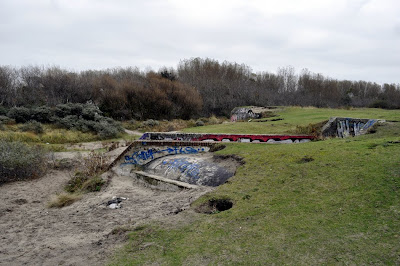A thirty minute train trip outside of Rotterdam takes you to Hoek van Holland a small coastal town where Rotterdam's shipping channel meets the North Sea. To the south, across the channel, is the Europoort, among the largest container ports in the world. Between 1941 and 1944, the German occupiers built defensive structures all along the coast in anticipation of an allied invasion. Today, the Hoek is a popular summertime beach destination with the Dutch and also with German tourists, who, as a Dutch friend insists, "still come to our beach to dig holes in the sand."
The remains of the defensive works are partly concealed amongst the dunes just inland from the beach and only frequented by miscreants and historians. With the passage of time, the bunkers are being slowly reclaimed by the environment. Parts are now concealed by brush or filled over by sand, while other areas are exposed by erosion from foot traffic, rabbit warrens, and exposure to the elements. The structures are now symbols in the landscape. Unlike our civil war battlefields in the US, which, with the passage of time, we've come to see as cherished landmarks and monuments of epic conflict and historic reconciliation, the antlantik wall is by no means 'canonized.' The German bunkers evoke an era of occupation close-at-hand: still within living memory for many Dutch people. For this segment of the population, the earthworks still provoke, and their decay is a more meaningful demonstration than their preservation.









Your work is very good and I appreciate you and hopping for some more informative posts. Thank you for sharing great information to us.
ReplyDeletePetes Construction